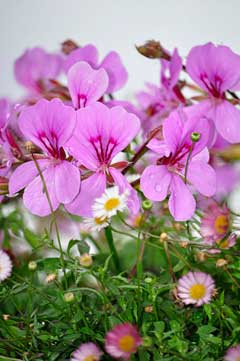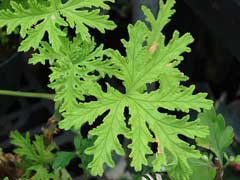 |
|
http://www.bjornlarsson.se/ |
 |
| http://www.hear.org/starr/ |
Translate this page:
Summary
Bloom Color: Pink. Main Bloom Time: Early summer, Late summer, Late spring, Mid summer. Form: Upright or erect.
Physical Characteristics

 Pelargonium graveolens is an evergreen Shrub growing to 1.2 m (4ft) by 0.8 m (2ft 7in) at a medium rate.
Pelargonium graveolens is an evergreen Shrub growing to 1.2 m (4ft) by 0.8 m (2ft 7in) at a medium rate.
See above for USDA hardiness. It is hardy to UK zone 9 and is frost tender. It is in leaf all year, in flower from May to July. The species is hermaphrodite (has both male and female organs).
Suitable for: light (sandy) and medium (loamy) soils and prefers well-drained soil. Suitable pH: mildly acid, neutral and basic (mildly alkaline) soils. It cannot grow in the shade. It prefers dry or moist soil.
UK Hardiness Map
US Hardiness Map
Synonyms
Plant Habitats
South Wall. By. West Wall. By.
Edible Uses
Edible Parts: Flowers
Edible Uses: Condiment Tea
Flowers - raw. Added to salads[183]. The leaves are rose-scented and are used as a flavouring in desserts, jellies, vinegars etc[183, 238]. The fresh leaves are brewed into a tea[183, 238].
References More on Edible Uses
Medicinal Uses
Plants For A Future can not take any responsibility for any adverse effects from the use of plants. Always seek advice from a professional before using a plant medicinally.
Antiinflammatory Antiseptic Aromatherapy Astringent Cancer Eczema Sedative
An aromatic, rose-scented herb, the whole plant has relaxant, anti-depressant and antiseptic effects, reduces inflammation and controls bleeding[238]. All parts of the plant are astringent[4]. It is used internally in the treatment of pre-menstrual and menopausal problems, nausea, tonsillitis and poor circulation[238]. Externally, it is used to treat acne, haemorrhoids, eczema, bruises, ringworm and lice[238]. The leaves can be used fresh at any time of the year[238]. The essential oil from the leaves is used in aromatherapy[238] and is also applied locally to cervical cancer[218].
References More on Medicinal Uses
The Bookshop: Edible Plant Books
Our Latest books on Perennial Plants For Food Forests and Permaculture Gardens in paperback or digital formats.

Edible Tropical Plants
Food Forest Plants for Hotter Conditions: 250+ Plants For Tropical Food Forests & Permaculture Gardens.
More

Edible Temperate Plants
Plants for Your Food Forest: 500 Plants for Temperate Food Forests & Permaculture Gardens.
More

More Books
PFAF have eight books available in paperback and digital formats. Browse the shop for more information.
Shop Now
Other Uses
Essential
a pelargonium that was well known since the 17th century for its use in food & beverages, tea, pot pourri & perfume, It is also very popular in Bulgaria where it is used in the production of rose geranium essential oil. An essential oil is obtained from the plant, it has an orange-rose fragrance[46, 104, 171]. This plant is the main constituent of geranium oil, which is used extensively in aromatherapy, skin care and as a food flavouring[238]. The leaves are used in pot-pourri[238].
Special Uses
Dynamic accumulator Scented Plants
References More on Other Uses
Cultivation details
Landscape Uses:Container, Specimen. Requires a light well-drained neutral to alkaline soil in a sunny position[188, 200]. Plants are not very hardy in Britain, they generally require greenhouse protection but might succeed outdoors when grown in a very sheltered warm spot in the mildest parts of the country[1]. They can also be grown in containers that are placed outdoors in the summer and then brought into the greenhouse or conservatory for the winter[238]. The plants need to be kept fairly dry in the winter[200]. Very tolerant of pruning, they can be cut right down to the base in the autumn when bringing them back indoors, or in the spring to encourage lots of fresh growth[238]. Cultivated for its essential oil in S. France and Spain[171], there are many named varieties[183, 200]. Special Features:
Attractive foliage, Fragrant foliage, Not North American native, Attracts butterflies, Attractive flowers or blooms.
References Carbon Farming Information and Carbon Sequestration Information
Temperature Converter
Type a value in the Celsius field to convert the value to Fahrenheit:
Fahrenheit:
The PFAF Bookshop
Plants For A Future have a number of books available in paperback and digital form. Book titles include Edible Plants, Edible Perennials, Edible Trees,Edible Shrubs, Woodland Gardening, and Temperate Food Forest Plants. Our new book is Food Forest Plants For Hotter Conditions (Tropical and Sub-Tropical).
Shop Now
Plant Propagation
Seed - best sown as soon as it is ripe in a greenhouse. Stored seed should be sown in early spring in a greenhouse. The seed germinates best with a minimum temperature of 13°c, germination usually taking place within 2 weeks though it sometimes takes some months[200]. Prick out the seedlings into individual pots when they are large enough to handle and grow them on in the greenhouse for at least their first winter. If trying them outdoors, plant them out in early summer and consider giving them extra protection during the winter. Cuttings succeed at almost any time in the growing season but early summer is the best time in order for the new plant to become established before winter.
Other Names
If available other names are mentioned here
Native Range
AFRICA: Mozambique, Zimbabwe, South Africa (Cape Province, Transvaal)
Weed Potential
Right plant wrong place. We are currently updating this section.
Please note that a plant may be invasive in one area but may not in your area so it's worth checking.
Conservation Status
IUCN Red List of Threatened Plants Status :

Growth: S = slow M = medium F = fast. Soil: L = light (sandy) M = medium H = heavy (clay). pH: A = acid N = neutral B = basic (alkaline). Shade: F = full shade S = semi-shade N = no shade. Moisture: D = dry M = Moist We = wet Wa = water.
Now available:
Food Forest Plants for Mediterranean Conditions
350+ Perennial Plants For Mediterranean and Drier Food Forests and Permaculture Gardens.
[Paperback and eBook]
This is the third in Plants For A Future's series of plant guides for food forests tailored to
specific climate zones. Following volumes on temperate and tropical ecosystems, this book focuses
on species suited to Mediterranean conditions—regions with hot, dry summers and cool, wet winters,
often facing the added challenge of climate change.
Read More
Expert comment
Author
L'Hér.
Botanical References
200
Links / References
For a list of references used on this page please go here
Readers comment